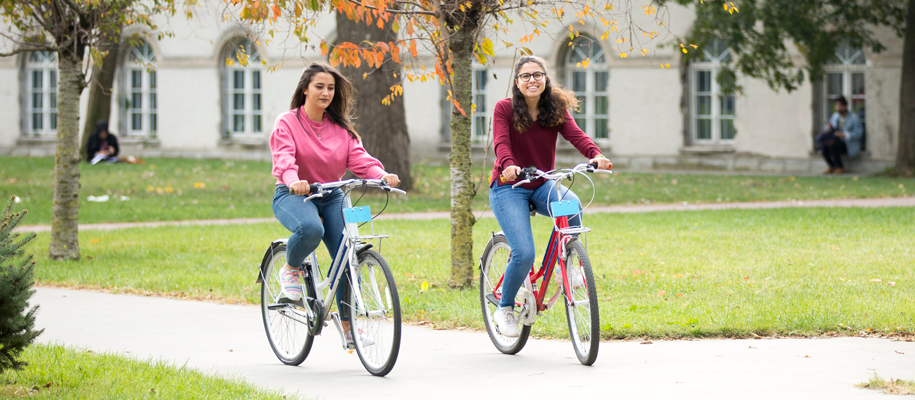College student Rebecca Kurnick had a quarter of a cow and half of a pig in her freezer. A large chest freezer, mind you. Kurnick and her roommate had purchased the freezer for only $100 on Craigslist in an effort to save some money—and maybe even the environment. While other students were filling their mini fridges with cheap beer and frozen candy bars, Kurnick and her environmentally conscious roommate were stocking their chest freezer with spinach and kale and, in a frugal effort to purchase in bulk, frozen cow and pig, which lasted the two of them through the entire semester!
Kurnick isn’t the only one concerned with her impact on the world. According to a survey by Inside Higher Ed, 85% of students say it’s at least somewhat important for their campus to prioritize sustainability. But if you’re not ready to buy sustainably raised meat in bulk, that’s okay. You can still take small steps toward sustainable living on campus in three important areas: in your transportation, in your residence hall, and in the dining hall.
1. Sustainable transportation options
Let's start with alternatives to getting around campus. Ditch the bus and borrow a bike! Universities are making it easy for students by introducing bike libraries and bike share programs, which allow students—particularly those who can't afford a bike or can't bring their bike to college—to cut down on burning fossil fuels. A bike library program allows students to check out a bike for an entire semester, while a bike share program allows students to check out a bike for a day (or less). “A benefit of both bike library and bike share programs is you give people the opportunity to try out biking on campus before they would have to invest in a bike of their own,” says Dana Schroeder, Sustainability Peer Educator Program Coordinator at Indiana University. Justin Mog, the Assistant to the Provost for Sustainability Initiatives at the University of Louisville, assists with a bike share program that allows students to check out a bike, lock, and helmet for free for the day with their student ID. “Maybe they’ll start biking for the rest of their life and they’ll invest in their own bike and they’ll continue that practice because it’s a great way to save money and stay healthy,” he says.
Related: 3 Easy Ways to Exercise in College (Without Hitting the Gym!)
2. Sustainable dorm life programs
Next up is residence hall living. One easy way to start living sustainably in your dorm is by participating in school reuse and resale programs. Universities regularly collect used housewares from students. Depending on the school, these items are donated to local stores and organizations, or donated or sold to students, which funds further sustainability efforts. For example, the Hoosier to Hoosier community sale collects used housewares from students in the spring and sells them back to students in the fall, funding sustainability efforts around Indiana University. “The Hoosier to Hoosier sale is trying to make our consumption of home goods more cyclical instead of linear,” says Schroeder, who also assists with the community sale.
First, a quick primer on the lifecycle of the stuff in your house. Housewares typically go through five stages: extraction, manufacturing, transportation, consumption, and disposal. While recycling only brings items from the disposal stage back to the manufacturing stage, reusing skips the manufacturing stage, bringing items from the disposal stage back to the consumption stage. Schroeder says college campuses are the ideal location for such reuse programs. “When you’ve got a new group of freshmen moving to campus every year and a group of seniors moving off campus every year, there’s a lot of turnover in the stuff that they use.”
Jane Diener, co-coordinator of Dawgs Ditch the Dumpster and Donate at the University of Georgia, says the goal of university reuse programs is to make donating more convenient than dumping. “Students don’t necessarily want to throw away these items, but at certain institutions, and previously at the University of Georgia, they didn’t really have an option—or at least from their perspective, they didn’t feel like had an option,” she says. “So this is giving them the option to do something great with an item they no longer have a need for.”
As Sustainability Program Coordinator at the University of Texas, Alyssa Halle-Schramm assists with the school's Trash to Treasure donation drive, which collects used housewares from students in the spring and, for only $1, sells the housewares (even used Apple products!) back to students throughout the following academic year, again funding sustainability efforts at UT. “It also helps the pocketbooks of students because you’re not going out to Target and buying a $15 lamp; you’re buying a $1 lamp at Trash to Treasure,” she says.
3. Sustainable dining hall practices
When it's time to eat on campus, opt for locally grown or raised food whenever possible. Universities are making it easy for students to do so by supporting local food festivals and sponsoring campus gardens. Corporate farming lacks biodiversity, depletes soil, burns fossil fuels, and encourages the use of artificial fertilizers, says Schroeder, who also assists with local food initiatives at Indiana U. In response, the University created a local food festival called Big Red Eats Green. Bringing in local producers underscores the benefits of eating local food and highlights its availability. “Big Red Eats Green is good because it’s right in the middle of campus, so people can walk by, and even if they didn’t plan on attending, they see this huge array of delicious, local, sustainable food and buy something that they wouldn’t buy normally and get hooked,” Schroeder says.
Indiana University also sponsors a campus garden, the Hilltop Garden & Nature Center, where student volunteers grow food that supports campus events. “Community gardens are great ‘gateway drugs’ for sustainability,” Schroeder says. “Getting your hands in the dirt is such a contrast to going to Walmart and buying an apple.”
At Montana State University, the Montana Harvest of the Month Program showcases food grown in local communities, with MSU Culinary Services promoting locally grown items in the dining halls. “Not only does it get people to eat things that are more fresh or more healthy or more sustainable, but it also really helps to support these producers,” says Rose Heider, who assists with local food initiatives at the University. Though students tend to believe that local food will break their budget, by buying in bulk and considering seasonality, they can stretch their wallets, Heider says. “It just takes a little bit of navigating to find the best ways to get that type of food into your budget.” (Even if that means stocking your chest freezer with half a cow and pig!)
Related: The Ultimate Vegetarian and Vegan Guide to Good Eating in College
As you can see, there's a growing awareness and commitment to sustainability among campus communities across the country. From eco-friendly transportation options to dorm life programs fostering reuse and dining hall practices promoting local sources, many colleges offer tangible ways for students to make a difference. Whether it's through small changes or bold initiatives, each step toward sustainability contributes to a healthier planet and a brighter future for all.
Want to keep reading about how students and colleges are going green? Check out all the articles and advice under our "sustainability" tag.







